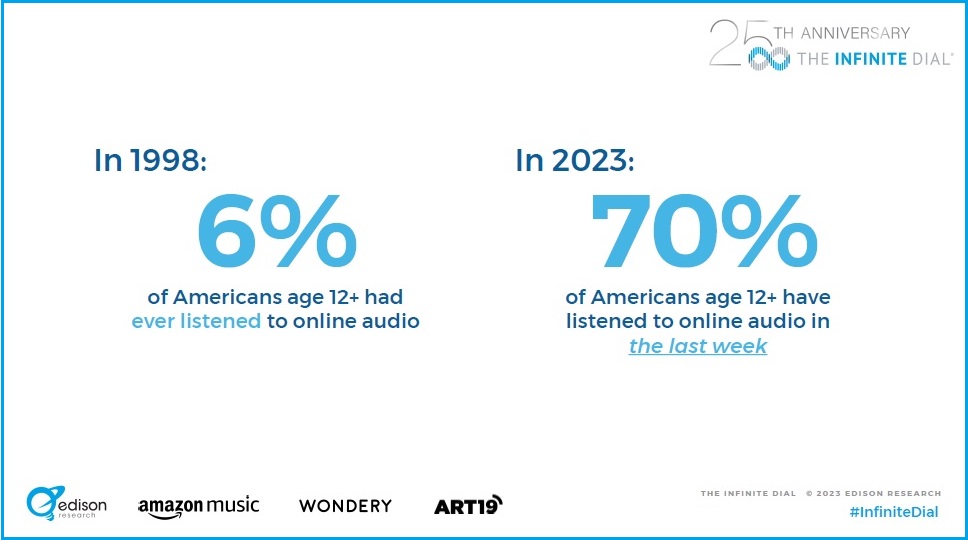As the winter of 2022-23 winds down, the rituals of spring begin. The ground hog says six more weeks of winter, although forecasts and 70-degree days suggest otherwise. The NAB Show is just around the corner.
And the results of the latest Infinite Dial are released.
This annual report is predictable in some ways, yet is also full of surprises. It reminds us to never be complacent, for a new player or disruptive technology often seems to be lurking in the wings.
This year, the Infinite Dial turns 25, the first survey having been conducted in 1998.
The opening slides document some of the many ways that America is a different country today than it was a quarter of a century ago.
We have become much more diverse. In 1998, 78 percent of the US population 12+ was white. Today, that number has dropped to just 58 percent.

Back then, we were just getting used to the internet, only 31 percent of us had access. In 2023, it’s nearly ubiquitous, with 95 percent of us online.

In 1998, the focus of The Infinite Dial was online audio, because that’s about all there was Only six percent of Americans 12+ had ever listened to it. Today 70 percent of Americans 12+ have listened to online audio in the past week.

When the Infinite Dial began, just 50 percent of Americans had a computer. Today, 91 percent of Americans have a smartphone, generally considered a replacement for the computer.

We’ve come a long way.
It is also interesting to consider this milestone from the perspective of the respondents, who have always been classified into three groups, 12-34, 35-54 and 55+. Simple arithmetic tells us that that the 1998 respondents are now the 37-59, 60-79 and 80+ groups. Many of those in today’s 12-34 group hadn’t been born when the Infinite Dial launched, and many more of those on the higher end of 55+, known as the Greatest Generation, have left our ranks. All who were surveyed in 1998 have passed through at least one demographic, those in the original 30-34 age bracket have passed through two, completing the cycle. What does this mean?
We are beginning to get enough hindsight to ponder questions about how we consume digital media over our lifetimes. The American author and motivational speaker Wayne Dyer (1940-2015) once observed that the things that are important and appropriate in one chapter of our lives may be less so, or inappropriate, in another. What has this got to do with demographics and media consumption?
Technology has given us the means to engage and interact with media in ways unimaginable in 1998. But in a stressful, fast-paced and noisy world, we might need to carve out some time to disengage, or at least engage with media that doesn’t expect us to do anything. Better still, spend a day at the shore, listening to the ocean. As we slide into the 55+ bin, this time for self-reflection and spiritual pursuits may become more important.
As we grow older, we may also question the real purpose of media in our lives. What does it mean to be an educated and informed citizen of the world in the 21st century? More media consumption, or something else? And if so, what?
None of this is to say that media consumption is without benefits, or that it is mutually exclusive with time spent on an inner journey. Only that the allocation of time between the two may change as we progress through our lives, and that should be part of the understanding.







